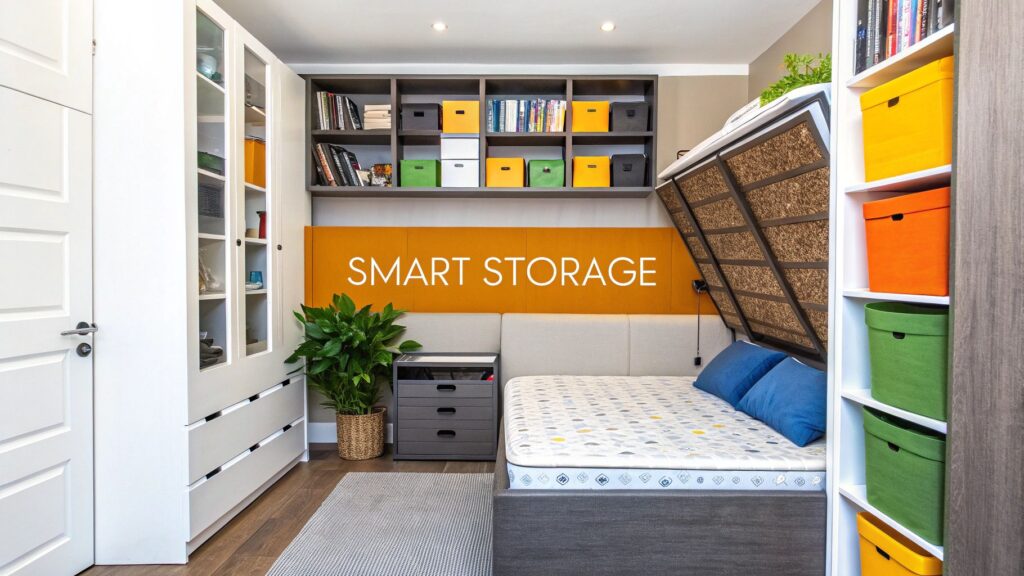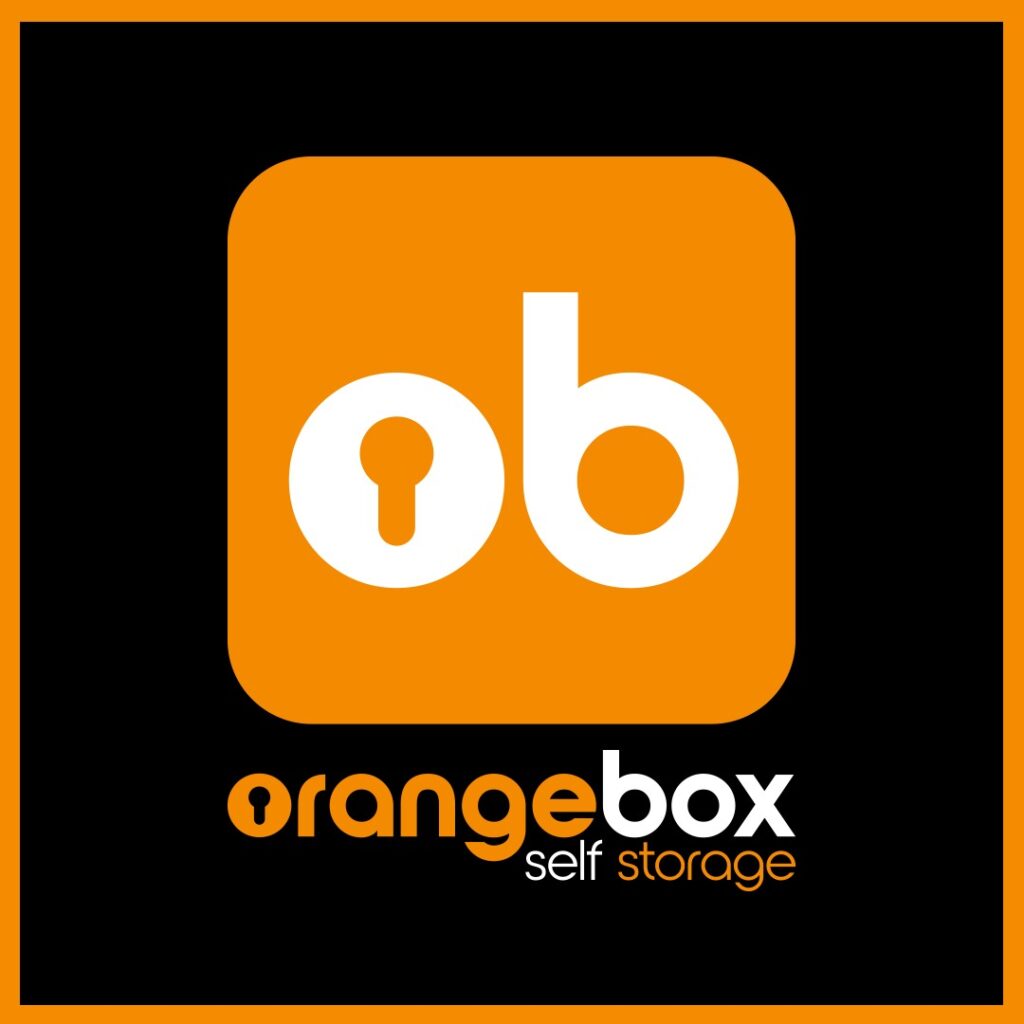Living in a small flat doesn't have to feel like a constant battle for space. The secret to effective storage solutions for small apartments isn't about having less stuff, but about being clever with the space you've got. It’s a mix of smart decluttering, using every inch of vertical space, and choosing furniture that works as hard as you do. Get it right, and you can transform a cramped room into an organised, calm, and functional home.
Your Roadmap to a Clutter-Free Apartment
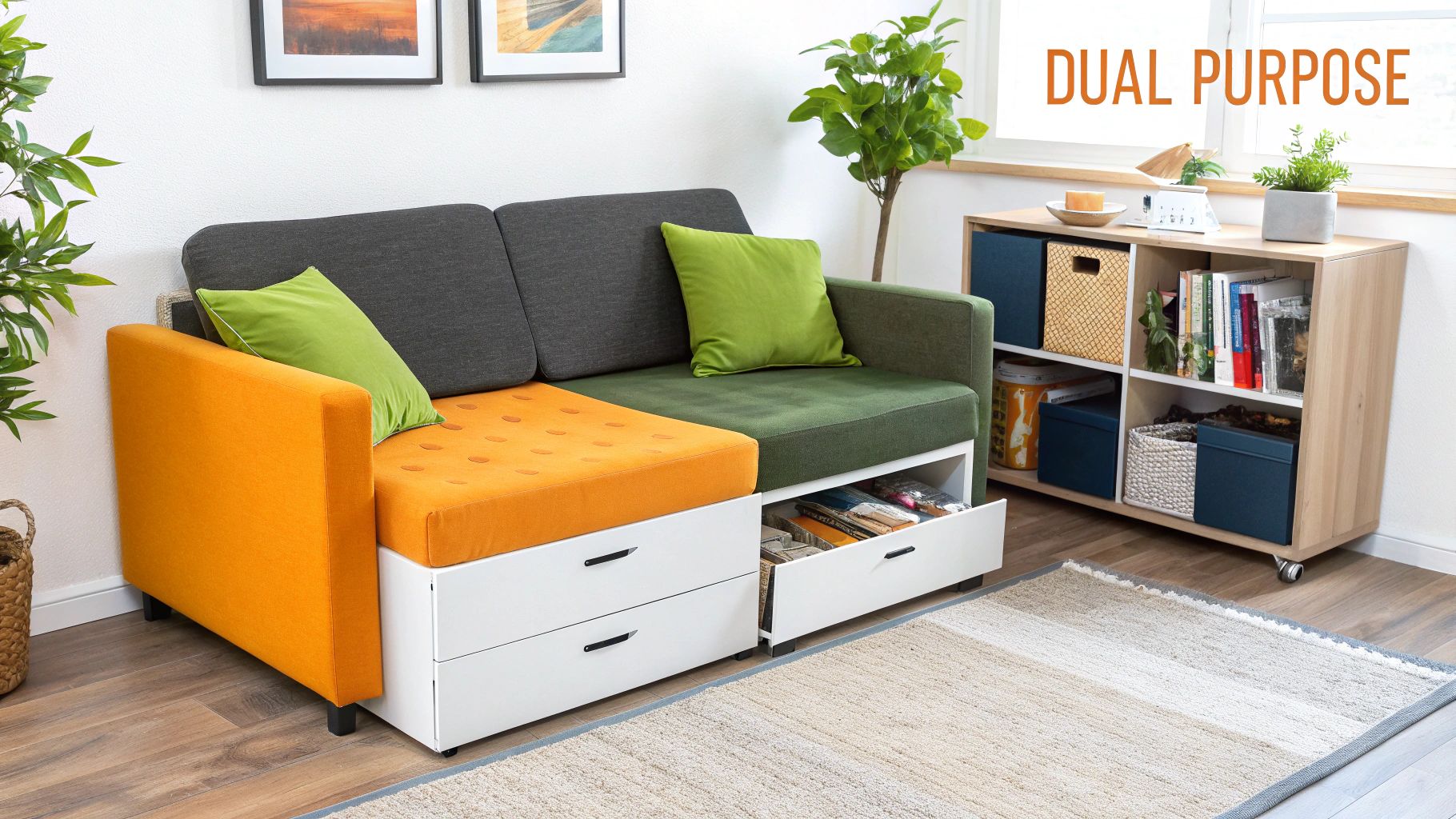
If you live in a compact UK flat, you know the feeling. That pile of books with nowhere to go, the winter wardrobe trying to escape in July, or the kitchen gadgets that have never seen the inside of a drawer—it all adds up. Before you know it, the clutter can feel completely overwhelming. But reclaiming your space isn't about finding some magical, one-size-fits-all solution. It’s about building a personalised system that actually fits your home and your lifestyle.
This guide is your practical roadmap to turning that frustration into a real sense of control. We're going to move beyond the usual generic tips and give you a proper plan to make your home feel more spacious, functional, and genuinely enjoyable to live in. Forget the idea that you just don't have enough room; the real issue is often all the untapped potential hiding right under your nose.
What This Guide Will Cover
To make a lasting change, we’ll break the process down into simple, actionable steps. This isn't just about a weekend tidy-up; it's about creating sustainable habits and making smart choices that keep your home organised for good.
Here’s what you can expect to learn:
- How to Conduct a Space Audit: You'll learn how to look at your flat with a professional eye, spotting "dead zones" and categorising your belongings to create a solid foundation for your storage plan.
- Mastering Smart Storage Techniques: We'll dive into using vertical space with wall-mounted shelves and harnessing the power of hidden storage in furniture like ottoman beds.
- Choosing Multi-Functional Furniture: Discover how to pick out pieces that do double duty, like expandable tables and modular units that can adapt as your needs change.
- Leveraging Off-Site Storage: Sometimes, the best solution is simply to get things out of the way for a while. We'll show you when it makes sense to consider options like flexible short-term storage for seasonal items or during a move.
By thinking strategically about every cupboard, corner, and wall, you can unlock a surprising amount of space. The goal is to make your apartment work for you, not the other way around.
This journey is about more than just getting rid of clutter. It’s about creating a peaceful, productive environment that makes your daily life better. Let's get started on making every square inch of your home count.
Conducting Your Home Space Audit
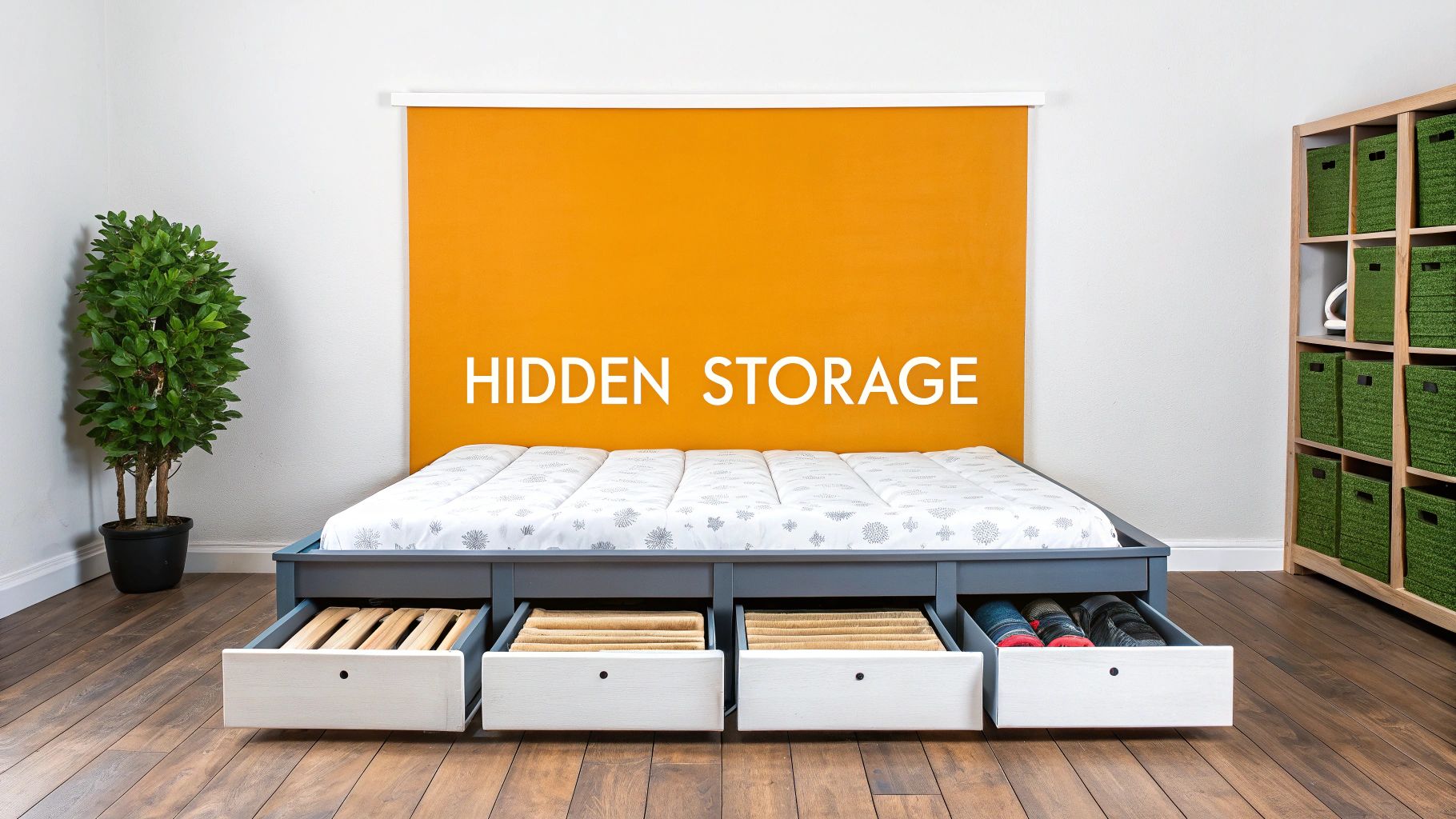
Before you buy a single storage box or even think about moving furniture, there's a crucial first step: understanding exactly what you're working with. This is where a Home Space Audit comes in. Think of it less like a frantic spring clean and more like a professional stocktake of your own flat.
The goal here is to shift your mindset from "I have no space" to a much more strategic "How can I best use the space I actually have?" It's a methodical process that involves mapping out your flat, measuring the nooks and crannies, and being brutally honest about your belongings. This audit gives you the hard data you need to create a plan that genuinely works, stopping you from wasting money on storage solutions that don't fit your home or your life.
This is especially true in the UK, where our homes are often on the compact side. The typical UK home is just under 72 square metres, which is quite a bit smaller than many of our European neighbours. It’s no surprise, then, that surveys show 40% of self-storage users say a simple lack of space at home is their main reason for needing extra room. Auditing your space first means you can find clever ways to maximise every inch before you even consider outside options. You can discover more UK self-storage industry statistics to see how others are tackling the same problem.
Mapping Your Apartment Layout
To kick things off, grab a piece of paper and sketch out a simple floor plan for each room. You don't need to be an architect—a basic drawing is perfect. The idea is just to visualise the flow of your home and start spotting those potential storage opportunities you might otherwise miss.
On your map, jot down the dimensions of each room and mark where large furniture like your sofa, bed, and wardrobes are. This visual guide will be invaluable when you start planning new storage for your flat, as it helps you see how new pieces will fit without having to drag heavy items around.
Identifying Underused Dead Zones
Every flat, no matter how tiny, has them: 'dead zones'. These are the goldmines of untapped storage potential, and your audit should be all about spotting them.
Keep an eye out for these common culprits:
- Above Wardrobes and Cabinets: That gap between the top of your furniture and the ceiling is prime real estate. It's perfect for stashing seasonal items or things you don't need every day.
- Beneath Windows: The space under a windowsill is often just sitting empty. A low bench with built-in storage or a narrow bookcase can fit perfectly here.
- In Corners: Awkward corners can be completely transformed with specialised corner shelving units, turning a useless area into a really functional storage spot.
- Over Doorways: It might sound odd, but a single shelf installed above a doorway can hold books, decorative boxes, or other items you rarely need to get to.
Taking the time to properly measure these zones is crucial. Knowing the exact height, width, and depth means you can buy storage units that fit like a glove, avoiding the sheer frustration of a purchase that’s a few centimetres too big.
The Four-Box Decluttering Method
Once you've mapped your space, the next step is to get real about your belongings. This isn't just about tidying; it's about making deliberate choices. The 'Four-Box Method' is a brilliantly simple yet powerful way to get it done.
Grab four large boxes (or just create four distinct piles) and label them: Keep, Donate, Store, and Discard. Go through your stuff one small area at a time—a single drawer, one shelf, or a section of your wardrobe—and put each item into one of the four piles.
- Keep: These are the things you use regularly and that have a clear, designated home in your flat.
- Donate: Items that are in good nick but you just don't need or love anymore.
- Store: Belongings you want to hang onto but don't need immediate access to. Think seasonal clothing, sentimental items, or bulky sports gear.
- Discard: Anything that's broken, expired, or no longer usable.
This process forces you to be decisive and immediately reduces the amount of stuff you need to find a home for. It clarifies what truly needs to be organised within your flat, making all the next steps feel far more manageable and effective.
Maximising Every Inch with Smart Storage
Right, you’ve done the hard work and finished your space audit. You now have a proper blueprint of your flat's storage potential. It's time to get clever and put that knowledge to work with two of the most effective strategies out there: vertical storage and hidden storage. These are the absolute cornerstones of smart storage solutions for small apartments.
Think of your floor space like prime real estate in Central London – every square inch is valuable. The more you can keep it clear, the bigger and more open your home will feel. The trick is to stop thinking horizontally and start looking up.
The Power of Going Vertical
The whole "go vertical" idea is dead simple but ridiculously effective. Instead of letting your stuff spread out and gobble up precious floor space, you build upwards. You start using that often-forgotten wall space that runs all the way to the ceiling. This way, you're adding storage without making the room feel like it's closing in on you.
Here are a few practical ways to make this happen:
- Tall, Slim Bookcases: A tall, slender bookcase gives you a massive amount of storage while taking up a tiny footprint. They’re brilliant for books (obviously), but also for decorative bits and storage boxes. They naturally draw the eye up, which has the added bonus of making your ceilings feel higher.
- Wall-Mounted Shelving: Floating shelves are a total game-changer, especially in cramped rooms. You can pop them up above desks, sofas, or even over doorways to hold anything from kitchen essentials to your vinyl collection, leaving the floor completely clear.
- Over-the-Door Organisers: Honestly, the back of a door is one of the most underused spots in any home. An over-the-door organiser can stash shoes in the bedroom, toiletries in the bathroom, or cleaning supplies in a cupboard, clearing clutter in an instant.
This infographic shows just how much of a difference a few smart organisation methods can make to a standard wardrobe.
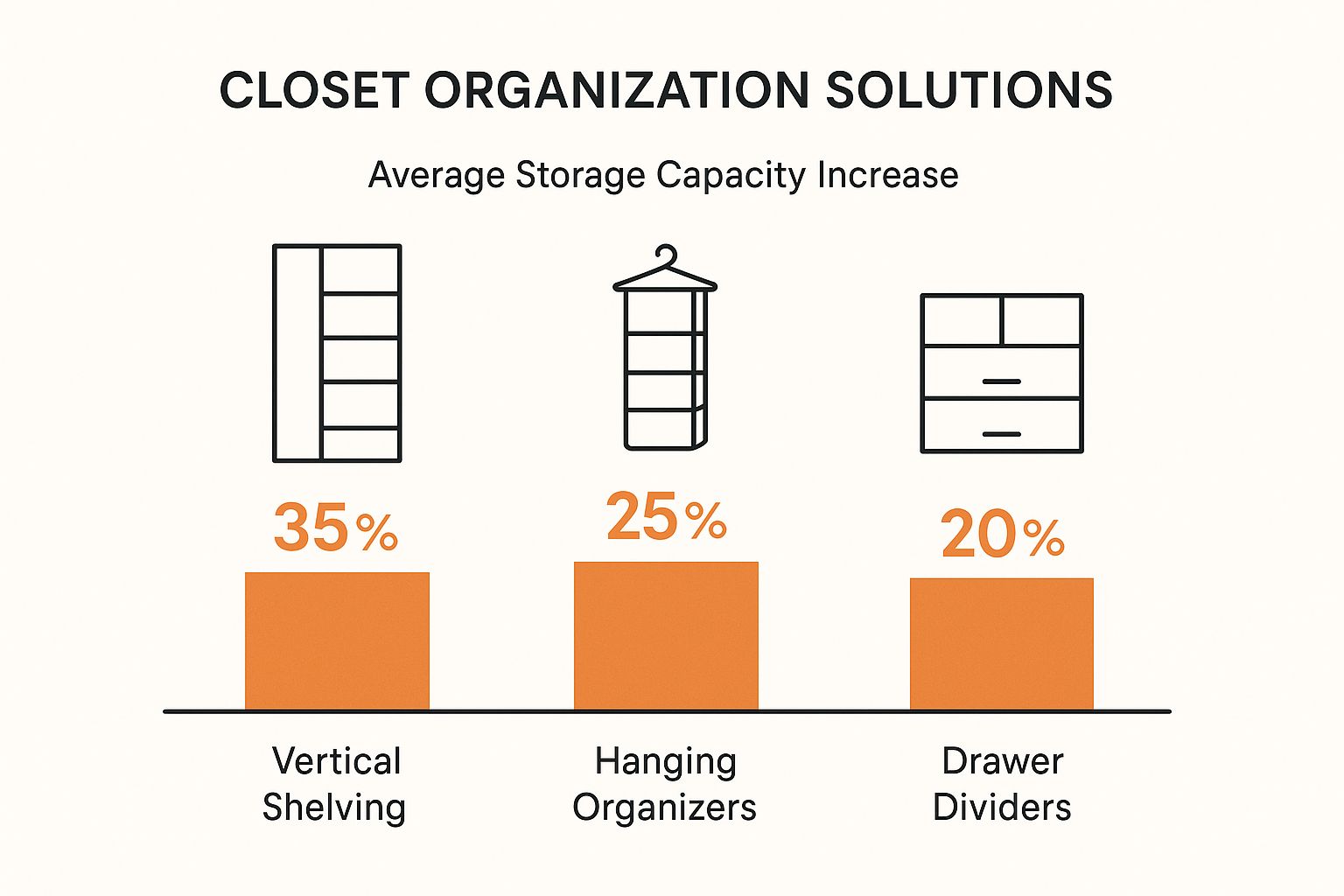
As you can see, just adding some simple vertical shelving can boost your usable wardrobe space by an incredible 35%, beating out other popular methods hands down.
Uncovering Hidden Storage Potential
While going vertical is all about being visibly smart with your walls, hidden storage is the art of making things disappear. It’s about choosing furniture and using nooks that cleverly tuck things away, helping you keep that clean, minimalist look. This is where you can really let your creativity shine.
Plenty of everyday furniture can pull double duty as secret storage spots, helping you keep the place tidy without having to live like a monk. In fact, a recent study found that nearly 60% of people feel more relaxed and focused in an organised home, and hidden storage is your fast track to getting there.
The best hidden storage solutions are the ones that blend right into your daily life. They shouldn't feel like a clunky add-on but a natural part of your home's design, making organisation feel completely effortless.
Smart Furniture and Clever Nooks
Ready to unearth the hidden potential in your flat? Start by looking at your biggest pieces of furniture and those awkward spots you pinpointed during your audit.
Multi-Functional Furniture:
- Ottoman Beds: These are pretty much the holy grail of hidden storage for a small bedroom. The entire mattress base lifts up to reveal a huge space underneath, perfect for stashing spare bedding, seasonal clothes, and those empty suitcases.
- Coffee Tables with Compartments: Keep an eye out for coffee tables with lift-up tops or built-in drawers. They’re the perfect place to hide remote controls, magazines, and all the other living room bits and bobs you want nearby but out of sight.
- Storage Benches: A simple bench in your hallway or at the end of your bed provides both a place to sit and a spot to chuck shoes, bags, or extra blankets.
Maximising Awkward Spaces:
- Inside Cabinet Doors: Stick small racks or organisers to the inside of your kitchen or bathroom cabinet doors. It’s an ideal spot for spice jars, cleaning sprays, or toiletries.
- Under-Stair Areas: If your flat has stairs, that space underneath is a goldmine. Custom-built drawers or shelves can turn this dead zone into a seriously functional storage hub.
- Window Seats with Storage: A built-in window seat not only gives you a cosy reading nook but can also be designed with a hinged lid to provide deep, discreet storage.
Deciding between visible vertical storage and clever hidden solutions often comes down to the room and what you need to store. This table breaks down the pros and cons of each approach.
Vertical vs Hidden Storage Solutions Comparison
| Storage Type | Best For | Pros | Cons |
|---|---|---|---|
| Vertical Storage | Books, decor, frequently used kitchen items, office supplies. Best for living rooms, kitchens, and home offices. | Maximises wall space; makes rooms feel taller; keeps items accessible and on display. | Can look cluttered if not organised; requires wall installation; visible storage isn't for everyone. |
| Hidden Storage | Bedding, seasonal clothing, shoes, living room clutter (remotes, magazines). Ideal for bedrooms and hallways. | Creates a minimalist, tidy look; reduces visual clutter; keeps items dust-free. | Can be less accessible for daily items; might require investing in specific furniture. |
Ultimately, you don't have to choose one over the other.
By combining the upward reach of vertical solutions with the discreet magic of hidden storage, you can dramatically boost your flat’s capacity. This two-pronged approach makes sure every last inch of your home is working smarter for you, creating a space that’s not just organised, but beautifully calm, too.
Choosing Furniture That Works Smarter
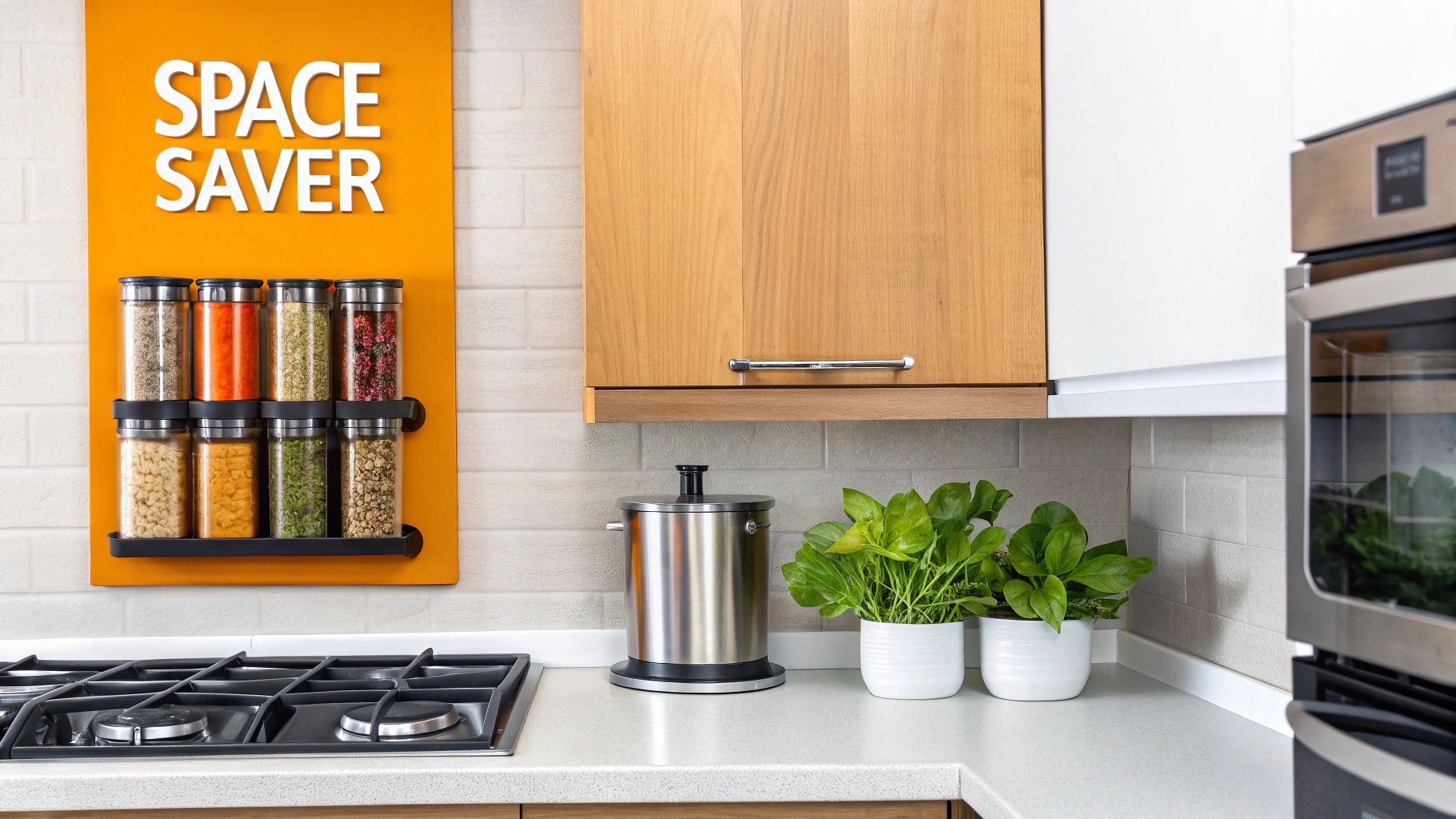
In a small flat, every single piece of furniture has to earn its keep. A bulky armchair that just sits there is a luxury you can’t afford when floor space is the most valuable thing you own. The secret to a home that’s both functional and stylish is picking furniture that works smarter, not harder. This means finding pieces that pull double duty.
Think of your furniture like members of a team. You don’t want a one-trick pony; you need versatile all-rounders that can pitch in wherever they’re needed. This approach is absolutely central to creating effective storage solutions for small apartments, because it weaves storage right into the fabric of your home instead of tacking it on as an afterthought.
By choosing items that serve more than one purpose, you automatically cut down on the total amount of furniture you need. This instantly frees up precious floor space, making your rooms feel bigger, brighter, and a whole lot less cluttered.
The Rise of Multi-Functional Furniture
Multi-functional furniture is the ultimate space-saving hero, packing two or more functions into one clever design. These pieces are perfect for compact living because they adapt to your day-to-day needs. Your living room can become a dining room, which can then transform into a guest bedroom, all thanks to a few smart choices.
Here are some of the most effective multi-functional heroes for your flat:
- The Sofa Bed: Modern sofa beds are a world away from the lumpy, uncomfortable contraptions of the past. Today’s designs are genuinely stylish and comfortable, turning a living room into a guest room in seconds.
- The Lift-Top Coffee Table: This is a real game-changer. It works as a standard coffee table, but the top lifts up to become a dining surface or a comfortable desk, often revealing hidden storage underneath for remotes and magazines.
- The Expandable Dining Table: Ideal for those who love to host but don’t have room for a huge table all year round. These tables can sit discreetly as a small console or a two-person desk, then pull out to seat six or more when you have company.
When you're looking at multi-functional furniture, always put durability first. A piece that’s going to be folded, lifted, and transformed all the time needs to be built to last. Look for sturdy mechanisms and high-quality materials.
Embracing Flexible Modular Systems
While multi-functional furniture is about one item doing multiple jobs, modular furniture is about creating a custom system that can grow and change with you. Think of modular pieces as building blocks for grown-ups. They’re made up of individual units you can combine, stack, or rearrange in countless ways, a flexibility that’s invaluable in a small flat.
Instead of hunting for a bookcase that fits perfectly into an awkward alcove, a modular system lets you build one that fits the space like a glove. If your needs change—maybe you get more books or need to carve out a home office—you can simply add, remove, or reconfigure the units. This adaptability means you won’t have to buy new furniture every time your life shifts.
Consider these powerful modular options:
- Modular Shelving: Systems from brands like IKEA let you mix and match cubes, shelves, and drawers. You can create a storage solution that’s perfectly tailored to your things and your space.
- Modular Sofas: These sectionals can be broken down into individual pieces and rearranged to suit any room layout. You can create a classic L-shape, a U-shape for movie nights, or even split them into separate chairs.
What to Look for When Buying
Choosing the right furniture is about more than just function; it’s also about getting the scale and style right. A piece might be incredibly clever, but if it’s too big or clashes with your decor, it’ll just add to the visual noise.
Before you buy anything, always, always measure your space carefully. Make sure there’s enough room not only for the furniture itself but for it to be used in all its different forms. For an expanding table, check you have clearance for chairs when it’s fully extended. For a sofa bed, be sure there’s enough room to pull it out without blocking a doorway. And pay attention to "visual weight"—pieces with slender legs and lighter colours tend to make a space feel much less crowded.
Using Self-Storage as a Home Extension
Even after the most ingenious decluttering hacks, you can still be left with one simple truth: you just have too much stuff for your space. This isn't a sign you've failed at organising. More often than not, it’s a sign that it’s time to think beyond your flat’s four walls. The trick is to reframe self-storage not as a last resort, but as a clever, flexible extension of your home.
Think of it as the spare room or garage you wish you had. It’s a secure, easy-to-reach space that holds the things you genuinely want to keep but simply don’t need day-to-day. This approach is one of the most effective storage solutions for small apartments because it instantly frees up precious living space, letting you enjoy a more minimalist, uncluttered life at home.
The UK's self-storage industry has grown massively to meet this exact need. As of 2024, there was over 64.3 million square feet of self-storage space, with the industry's annual turnover now topping £1.2 billion. Tech has also made facilities more convenient, with 15% of stores now running without permanent staff on-site, offering far more flexibility. You can see just how much the industry has grown in this comprehensive annual report.
When Self-Storage Makes Perfect Sense
Deciding to use a storage unit isn't just for huge life events like moving house. It’s a seriously practical fix for many of the everyday situations that create clutter in a compact flat.
You should consider a unit if you need to store:
- Seasonal Items: That bulky winter wardrobe, the mountain of Christmas decorations, or the summer garden furniture has no business hogging precious cupboard space all year round.
- Sports & Hobby Equipment: Skis, camping gear, bikes, or kayaks are vital for your lifestyle but can be a nightmare to store neatly in a small apartment.
- Sentimental Belongings: Family heirlooms, boxes of old photos, or treasured collections deserve to be kept safe, but they don't need to be tripping you up every day.
- A Temporary 'Holding Zone': During a redecoration, a small renovation, or even when downsizing, a unit gives you a secure place to hold furniture and boxes without the chaos.
By moving these kinds of items off-site, you immediately create more breathing room at home. All of a sudden, that cluttered corner can become a cosy reading nook, or the wardrobe that was bursting at the seams now closes with ease.
How to Choose the Right Storage Unit
Finding the right self-storage unit is what makes this whole strategy work. It needs to be convenient, secure, and the right size for what you've got. Rushing this decision often leads to hassle down the line, so it's worth taking a moment to think about what really matters.
A self-storage unit should feel like a natural extension of your home—secure, clean, and easy to get to whenever you need it. Prioritise these things over just finding the absolute cheapest option.
Here’s a practical checklist to help you find the right place:
- Location: Pick a facility that’s easy for you to get to. If you think you'll be popping back and forth regularly, a location near your home or on your commute is a must.
- Security: This is completely non-negotiable. Look for facilities with 24/7 CCTV monitoring, secure electronic gate access, and decent lighting. Your belongings should be just as safe there as they are in your home.
- Unit Size: Don't pay for space you don't need. Most places offer a huge range of sizes, from small lockers to units the size of a garage. Use their online estimators or have a chat with the staff to find the perfect fit.
- Accessibility: Check the access hours. Some facilities offer 24/7 access, while others have more restricted times. Make sure their schedule actually works with yours.
- Type of Storage: You’ll often have a choice between different kinds of units. It's worth taking a minute to compare indoor vs. container storage options to see which will better protect your specific items from things like temperature changes and damp.
By carefully choosing an external unit, you’re not just clearing out clutter; you’re making a smart investment in a more peaceful and functional living space at home.
Creating a Sustainable Organisation System
Getting your flat organised is a fantastic feeling, but the real win is keeping it that way. You’ve done the hard work—auditing your space, thinking vertically, and picking out clever furniture. Those are the foundations. Now, it’s time to move past the one-off tidy-up and build a system that stops clutter from creeping back in.
Maintaining a peaceful, organised home isn’t a single event; it’s a daily practice built on simple, powerful habits. Think of it like looking after a garden. You can’t just plant everything and walk away. It needs consistent, gentle weeding to stop unwanted plants from taking over. Your home works in exactly the same way.
Adopting the One-In, One-Out Rule
One of the most effective habits you can pick up is the ‘One-In, One-Out’ rule. It’s a beautifully simple idea that acts as a gatekeeper for your home, preventing new clutter from ever getting a foothold.
The rule is straightforward: for every new thing you bring into your flat, something similar has to leave. Buy a new pair of shoes, and an old pair gets donated. Bring home a new book, and one from your shelf goes to a friend. This creates a constant, manageable cycle of decluttering that never feels overwhelming.
This habit forces you to be more mindful about what you buy. Instead of asking, "Where will I put this?" you start asking, "What will this replace?" It completely shifts your relationship with 'stuff'.
Building Your Long-Term Action Plan
A sustainable system pulls together all the strategies we’ve talked about into one cohesive plan. It’s all about giving everything a designated home and making tidying a natural part of your routine, not some monumental chore you put off for weeks. The goal is to make staying organised feel almost effortless.
Your long-term action plan should be built on these core pillars:
- Regular Mini-Audits: No need for another full-scale audit. Just a quick 15-minute review of a cupboard or a drawer each month is enough to catch clutter before it builds up.
- Vertical and Hidden Systems: Keep using your vertical shelves and hidden storage as they were intended. A few labels on boxes and containers will make finding things—and putting them away again—quick and painless.
- Leverage Smart Furniture: Actively use the multi-functional parts of your furniture. Fold away that desk or extend that table to remind yourself just how adaptable and spacious your home can be.
- Strategic Off-Site Storage: Your self-storage unit is your secret weapon for a calm home. Schedule in seasonal swaps—say, in October and April—to exchange your summer and winter wardrobes or decorations. This keeps your flat's precious storage focused only on what's relevant right now. Exploring options for personal storage can make this process completely seamless.
By weaving these simple practices into your daily and weekly life, you build a powerful system that preserves the calm and order you’ve worked so hard to create. You’re giving yourself the tools to maintain a peaceful, productive, and permanently organised home.
Your Top Storage Questions Answered
When you're trying to figure out storage for a small flat, a lot of questions can pop up. From worrying about the cost to deciding what's actually worth putting away, getting the right answers makes all the difference. Here, we tackle some of the most common queries we hear from people living in cosy UK homes.
What’s the Most Cost-Effective Storage Solution?
Honestly, the most budget-friendly option is to get creative with the space you already own. Before you spend a penny, make sure you’ve maxed out every possibility – think vertical shelving, under-bed boxes, and clever, multi-functional furniture.
But when you've genuinely hit a wall and there's no more room to be found, self-storage is often a much smarter financial move than upgrading to a bigger, pricier flat. The secret is picking the right-sized unit so you’re not paying for air. A small locker for a few boxes will always be more affordable than a large unit you can’t hope to fill.
How Do I Know What’s Worth Storing Off-Site?
A great rule of thumb is to think about how often you use something versus how much it means to you. If you use it less than once a year but can’t imagine parting with it, it's the perfect candidate for self-storage.
Think about boxing up things like:
- Seasonal Gear: Your bulky winter coats, Christmas decorations, and summer sports equipment.
- Sentimental Items: Family heirlooms, old photo albums, and the kids' artwork you can't throw away.
- Bulky Hobby Equipment: Camping gear, that guitar you love, or large art supplies.
- Temporary Items: Furniture and other bits you need out of the way while you redecorate.
The whole point of off-site storage is to reclaim your immediate living area for everyday life. It's about giving yourself breathing room by safely tucking away the things you love but don't need right at your fingertips.
Is Self-Storage Actually Secure?
Security is a huge deal for us, and modern facilities are incredibly safe. It's true that some people are wary—research shows that 41% of customers are cautious about unmanned facilities—but the industry has stepped up. Today, 82% of UK stores have extensive CCTV systems to give you total peace of mind.
The proof is in the experience: a massive 88% of users report being happy with their storage. In fact, 35% of users now rely on online reviews to pick a facility, which shows just how vital a trusted reputation has become. You can see more details in the latest self-storage report findings.
When you're choosing a unit, keep an eye out for features like 24/7 CCTV, secure electronic gate access, and good lighting. Just as important is packing your items properly to prevent any damage – it’s a common pitfall! For more practical tips, check out our guide on the 8 common storage unit mistakes and how to avoid them.
At Orange Box Self Storage, we provide secure, flexible, and affordable storage to help you reclaim your living space. Find the perfect unit for your needs by visiting us at https://orangebox-selfstorage.co.uk.

